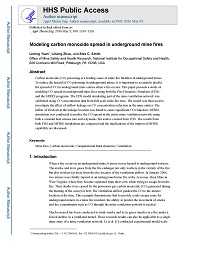Mining Publication: Modeling Carbon Monoxide Spread in Underground Mine Fires
Original creation date: May 2016
Carbon monoxide (CO) poisoning is a leading cause of mine fire fatalities in underground mines. To reduce the hazard of CO poisoning in underground mines, it is important to accurately predict the spread of CO in underground mine entries when a fire occurs. This paper presents a study on modeling CO spread in underground mine fires using both the Fire Dynamics Simulator (FDS) and the MFIRE programs. The FDS model simulating part of the mine ventilation network was calibrated using CO concentration data from full-scale mine fire tests. The model was then used to investigate the effect of airflow leakage on CO concentration reduction in the mine entries. The inflow of fresh air at the leakage location was found to cause significant CO reduction. MFIRE simulation was conducted to predict the CO spread in the entire mine ventilation network using both a constant heat release rate and a dynamic fire source created from FDS. The results from both FDS and MFIRE simulations are compared and the implications of the improved MFIRE capability are discussed.
Authors: L Yuan, L Zhou, AC Smith
Peer Reviewed Journal Article - May 2016
NIOSHTIC2 Number: 20047865
Appl Therm Eng 2016 May; 100:1319-1326
See Also
- Artificial Neural Networks to Determine Ventilation Emissions and Optimum Degasification Strategies for Longwall Mines
- CFD modelling of sampling locations for early detection of spontaneous combustion in long-wall gob areas
- CO and CO2 Emissions from Spontaneous Heating of Coal Under Different Ventilation Rates
- The Critical Ventilation Velocity in Tunnel Fires - A Computer Simulation
- Development and Application of Reservoir Models and Artificial Neural Networks for Optimizing Ventilation Air Requirements in Development Mining of Coal Seams
- MFIRE Users Manual Version 2.20
- Mine Face Ventilation: A Comparison of CFD Results Against Benchmark Experiments for the CFD Code Validation
- Modeling and Prediction of Ventilation Methane Emissions of U.S. Longwall Mines Using Supervised Artificial Neural Networks
- Specialized Fortran Computer Programming and Analysis Services to Upgrade Capability of MFIRE Program
- Study of Mine Fires and Mine Ventilation: Part I, Computer Simulation of Ventilation Systems Under the Influence of Mine Fires
- Content source: National Institute for Occupational Safety and Health, Mining Program


 ShareCompartir
ShareCompartir
